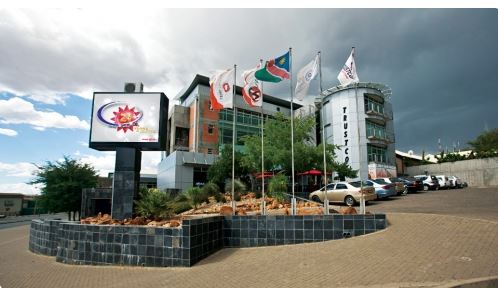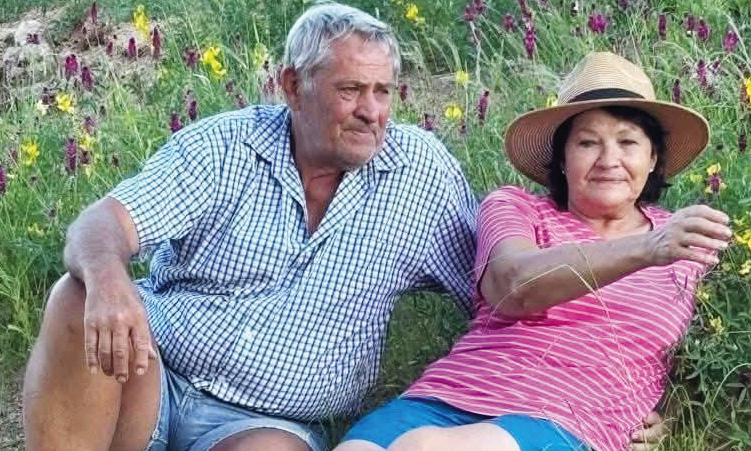HERE and there you’ll find some nut cases amongst otherwise rational proponents of homo sapiens, having pipe dreams of clasping the rubbery fingers of extraterrestrials.
I, myself, have discarded my childhood dream of meeting creatures from Mars – long ago – and am no longer in search of UFOs. Therefore it is all the more exciting, to be surprised by something unexpected and be able to stare in childlike awe at something again.In the ‘deep south’ of Namibia, where jackal and ground squirrel wish each other a good night’s rest, lies a prominent table mountain range, named after a certain German nobility clan.Though no men from Mars were visible on its slopes, my husband and myself discovered a whole forest of ‘half humans’, said to be in danger of extinction.We could hardly believe our eyes: Right in front of us, behind us, next to us was a virtual forest of those extraordinary and fascinating plants with their high, inverted, bottle-shaped, thorny trunks ending in a punk-style shock of hair of dark green, soft, undulating leaves! Five of the 13 species of the stem succulents of the Oleander Family, scattered throughout Africa and Madagascar, occur in South Africa (Richtersveld) and in southern Namibia.They can – similar to us – reach a maximum age of just over 100 years.There is another similarity between the Pachypodium namaquanum (generic name, which literally translated means ‘thick foot’) and the human biped-specie homo sapiens sapiens.We humans tend to become more mild with age, shed the sharp thorns (not to mention hair) of our ‘Sturm-und-Drang-Zeit’ and exchange them for more gentle features around our otherwise wrinkled faces.At a young age our young ‘elephants trunk’, as it is also popularly known, is covered in wart-like buttons, from which sharp thorns protrude.The older the succulent gets, the more of these spines it loses, especially around the base and lower half of its stem.We, on the other hand, lose our teeth and hair and become less bitchy, in other words, less thorny as well.The comparison does not end here.Both species are sun worshippers.We stretch out supine on the beach in order to tan or feed our body with the ‘happy hormone’ vitamin D.Certain members of our species spend the Namibian winter time in warm Europe and resettle again in Namibia in summer time in order to enjoy as much warmth as possible.Our thick foot on the steep mountain slopes also bears the common name of ‘noordboom’ because of its tendency to bend its crown northwards towards the sun.This it does in order to guarantee optimal photosynthesis during winter as well as a minimum loss of humidity during summer, the latter being of even greater importance because of the fact that our succulent loses its leaves during the summer month – as we tend to lose our hair with age.This is called its heliotropic tendency (helios = sun in Greek) Levyn claims in Die Afrikaanse Kinderensiklopedie that the Khoi-Khoi of Namaqualand gave the name ‘halfmens’ to the plant.He relates how, long ago, their ancestors lived north of the Orange River and had to flee southward in the face of their enemies.After having crossed the river, they looked back with heartache at the land they had to leave.Those who longed for their land turned into stone, with their faces turned towards the north.They remain so to this day! Indeed these erect standing plants look like ghostly human forms, especially at dusk.Should anyone still long to discover Martians on the Red Planet, let me assure you that there are much more interesting things to be discovered on our own planet earth, in southern Namibia, to be more precise.Therefore it is all the more exciting, to be surprised by something unexpected and be able to stare in childlike awe at something again.In the ‘deep south’ of Namibia, where jackal and ground squirrel wish each other a good night’s rest, lies a prominent table mountain range, named after a certain German nobility clan.Though no men from Mars were visible on its slopes, my husband and myself discovered a whole forest of ‘half humans’, said to be in danger of extinction.We could hardly believe our eyes: Right in front of us, behind us, next to us was a virtual forest of those extraordinary and fascinating plants with their high, inverted, bottle-shaped, thorny trunks ending in a punk-style shock of hair of dark green, soft, undulating leaves! Five of the 13 species of the stem succulents of the Oleander Family, scattered throughout Africa and Madagascar, occur in South Africa (Richtersveld) and in southern Namibia.They can – similar to us – reach a maximum age of just over 100 years.There is another similarity between the Pachypodium namaquanum (generic name, which literally translated means ‘thick foot’) and the human biped-specie homo sapiens sapiens.We humans tend to become more mild with age, shed the sharp thorns (not to mention hair) of our ‘Sturm-und-Drang-Zeit’ and exchange them for more gentle features around our otherwise wrinkled faces.At a young age our young ‘elephants trunk’, as it is also popularly known, is covered in wart-like buttons, from which sharp thorns protrude.The older the succulent gets, the more of these spines it loses, especially around the base and lower half of its stem.We, on the other hand, lose our teeth and hair and become less bitchy, in other words, less thorny as well.The comparison does not end here.Both species are sun worshippers.We stretch out supine on the beach in order to tan or feed our body with the ‘happy hormone’ vitamin D.Certain members of our species spend the Namibian winter time in warm Europe and resettle again in Namibia in summer time in order to enjoy as much warmth as possible.Our thick foot on the steep mountain slopes also bears the common name of ‘noordboom’ because of its tendency to bend its crown northwards towards the sun.This it does in order to guarantee optimal photosynthesis during winter as well as a minimum loss of humidity during summer, the latter being of even greater importance because of the fact that our succulent loses its leaves during the summer month – as we tend to lose our hair with age.This is called its heliotropic tendency (helios = sun in Greek) Levyn claims in Die Afrikaanse Kinderensiklopedie that the Khoi-Khoi of Namaqualand gave the name ‘halfmens’ to the plant.He relates how, long ago, their ancestors lived north of the Orange River and had to flee southward in the face of their enemies.After having crossed the river, they looked back with heartache at the land they had to leave.Those who longed for their land turned into stone, with their faces turned towards the north.They remain so to this day! Indeed these erect standing plants look like ghostly human forms, especially at dusk.Should anyone still long to discover Martians on the Red Planet, let me assure you that there are much more interesting things to be discovered on our own planet earth, in southern Namibia, to be more precise.
Stay informed with The Namibian – your source for credible journalism. Get in-depth reporting and opinions for
only N$85 a month. Invest in journalism, invest in democracy –
Subscribe Now!










